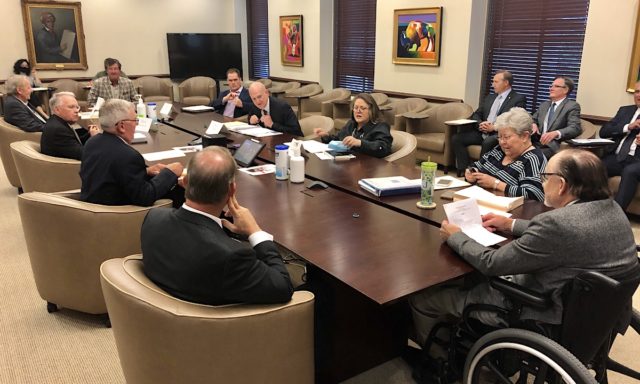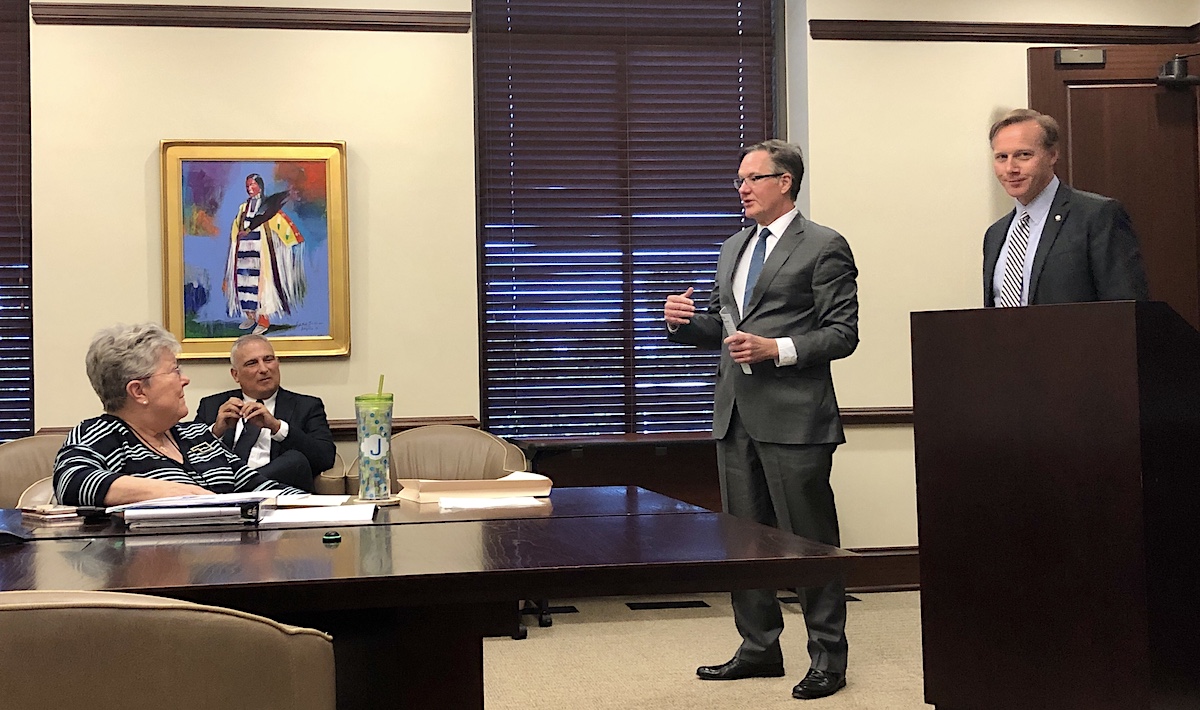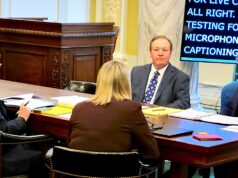
The Oklahoma Board on Judicial Compensation held its biannual meeting today and voted to recommend a 7.67 percent across-the-board pay raise for judges, which would take effect in 2022 unless modified or rejected by the Oklahoma Legislature.
The increase would range from more than $12,000 for Oklahoma Supreme Court justices to about $9,400 for special district court judges — see the chart below — and it would bring Oklahoma judges to roughly the regional average among Colorado, Arizona, Missouri, Texas, New Mexico and Kansas.
Board members discussed the matter for 90 minutes, hearing from Supreme Court Justice Richard Darby, Court of Criminal Appeals Presiding Judge Scott Rowland, McAfee & Taft shareholder Michael Lauderdale, Cleveland County District Judge Thad Balkman and Oklahoma County District Judge Richard Ogden.
All five men advocated for the board — comprised of two gubernatorial appointees, four legislative appointees and a designee of Darby himself — to recommend a judicial pay raise in an effort to attract more and better applicants and candidates for judicial positions.
In their capacities as leadership of the Oklahoma Judges Association, Balkman and Ogden specifically recommended the 7.67 percent figure.
“We’re suggesting that you make it competitive to what our counterparts in surrounding states make,” Balkman said after presenting regional average salary data for judges of general jurisdiction. (In Oklahoma, district courts are the courts of general jurisdiction.)
Ogden said he was a practicing attorney for 24 years before being appointed to the bench in Oklahoma County, a career-long goal.
“But I also fully appreciate the fact that, for others in my same position, it would very much be a deterrent for them to, after 25 years, say, ‘I’m going to sail away and leave all of my belongings on shore,'” Ogden told the board. “That is what we do as judges, and many people don’t realize that. We can’t practice law. We are very limited in what we can do in terms of other sources of active income, and so you basically have made a life, and you leave that on shore, and you jump in a ship and sail away. And to ever go back to that would be very difficult because other people have taken your belongings — your clients — and they’re not there anymore.”
After Balkman and Ogden left, the board discussed inflation, regional averages, cost of living differences and historical pay-raise recommendations that were cut in half by lawmakers.
In September 2019, the board had recommended a 9 percent increase for all judges. But during the 2020 legislative session, economic uncertainty related to negative petroleum prices and other pandemic problems led lawmakers to consider killing the entire pay raise recommendation.
They eventually chose to approve only half of the suggested pay raise, a 4.5 percent hike that also triggered subsequent pay increases for district attorneys, court clerks and other public employees. (Ogden noted that Oklahoma had ranked 42nd in judicial pay prior to the 2020 pay raise. Now the state ranks 41st.)
The Legislature’s decision to approve only half of the 2019 recommended judicial pay raise sat poorly with Board on Judicial Compensation member Sean Ziese, a Cherokee County machine-shop owner appointed by Gov. Kevin Stitt.
“As far as the 7.6 percent, I have no problem there,” Ziese said. “My biggest fear is they’re going to get it cut down from there. I would rather ask for a little bit more in case it does get cut.”
Ziese’s idea of recommending a higher figure as gamesmanship gained little traction, however, with former Norman Transcript editor Andy Rieger ultimately making a motion for the 7.67 percent increase, rounded to the nearest dollar amount for each position.
Jari Askins, administrative director of the courts, told the board that legislative leaders had requested a dollar figure instead of a percentage in an effort to deal with round numbers. (As a member of the Oklahoma House, Askins carried the legislation that created the Board on Judicial Compensation nearly two decades earlier.)
Mark Nichols, the appointee of Justice Darby, seconded Rieger’s motion, and the board approved making the recommendation unanimously.

‘You want the best and brightest as your judges’
After the meeting, Rieger said he was persuaded to recommend another judicial pay raise owing to a primary talking point from Balkman, Ogden and Lauderdale: Fewer attorneys are seeking open judicial positions than before.
“Fewer applicants is a concern, because you want the best and brightest as your judges,” said Rieger, who was appointed by House Speaker Charles McCall (R-Atoka).
Lauderdale had told the board that the current judicial salary scale “is a deterrent from moving from the private sector into a public service position as a judge.”
“I’m hoping that over a period of time we can start moving that needle to where it won’t become a deterrent,” he said. “If you look at the applicants that are coming in — that are applying for jobs — when they go through the Judicial Nominating Commission, we are seeing a shrinkage. We are seeing going from 30 to 20 to 10, sometimes as little as five. Sometimes in the rural counties, you only get three. So absent some competitive baseline salary increase, I’m worried what it’s going to be like in 10 years.”
Darby, who was appointed to the state Supreme Court by Gov. Mary Fallin in 2018, opened the day’s meeting by saying judicial pay is “a matter of great importance” to him personally, but not owing to his own pocketbook.
“If I need to go to court or a family member needs to go to court, I want the best person available to be serving as a judge,” Darby said. “And the fact is, to attract the best person, we need to provide the best in return for their services.”
Darby, whose family owns Darby’s Big Furniture in Duke, said he became a judge 35 years ago at a salary of $48,000.
“That wasn’t bad pay for a 28-year-old kid,” he said. “But folks now — young lawyers, middle aged lawyers that think about maybe applying for an opening — they are going to look at the salary. They just are. (…) In many cases, it would prevent somebody from doing it, and I don’t want that.”
Rowland, the Court of Criminal Appeals presiding judge, spoke after Darby.
“I’m a Republican who likes government. Maybe that makes me a little bit of an anomaly,” Rowland said. “But I’ve always been intrigued about how a lot of the heavy lifting in government is done by citizen boards and commissions, largely laboring in anonymity behind the scenes.”
A former prosecutor and general counsel for the Oklahoma Bureau of Narcotics and Dangerous Drugs, Rowland was appointed to the appellate court by Fallin in 2017.
“I believe that we attract good people to judicial office most of the time now,” he said. “I believe that we would continue to consistently attract the best candidates in both public and private sector as long as attention is paid keeping that salary at least somewhat commensurate.”
Follow @NonDocMedia on:
‘You really don’t want them to work on this too hard’
As the board asked questions of judges Balkman and Ogden, members pondered the value of state benefits and Oklahoma’s relatively low cost of living.
“You don’t believe that the cost of living, I take it, should enter into our thoughts when we consider the regional averages?” asked David Pitts, a Stillwater banker appointed by Senate President Pro Tempore Greg Treat (R-OKC).
A former Oklahoma House of Representatives member from Norman, Balkman replied that he is “not an economist” and reminded the board that judicial pay in Oklahoma is the same across all 77 counties.
“A lot of what you have said is really a proper question for the Legislature to set policies, to set priorities and to fund it. And we hope they do,” Balkman said. “[It is a question of] what they want to see [the] judiciary look like.”
Pitts later said “inflation is upon us,” but also noted that Oklahoma judges’ salaries go farther than those of many of their peers around the nation.
“If you look at cost of living, we are 25th,” he said. “I think that, in my mind, impacts what I think. If we lived in New York, the salaries here would be laughed at.”
As the board determined how to present its recommendation to the Legislature, member Sheryl Lovelady, a former public relations professional appointed by Treat, questioned how to format the suggested pay increase. Instead of stating a simple percentage, she asked whether writing out specific salary amounts for all judicial levels might “expose that to more discussion by the Legislature.”
“It’s always that game of, like, ‘What’s the easiest thing?'” Lovelady said. “Because you really don’t want them to work on this too hard.”
The effect of a 7.67 percent judicial pay raise

A 7.67 percent across-the-board pay raise for Oklahoma judges will take effect in 2022 unless the Oklahoma Legislature modifies or rejects the recommendation. (Provided)





















